Related Research Articles
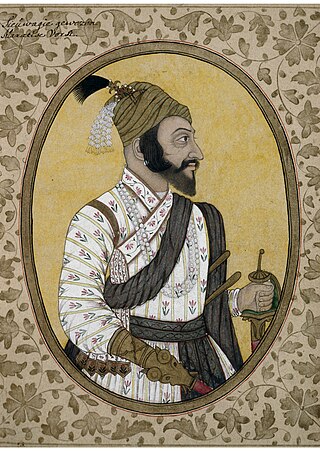
Shivaji I was an Indian ruler and a member of the Bhonsle Dynasty. Shivaji carved out his own independent kingdom from the declining Adilshahi Sultanate of Bijapur that formed the genesis of the Maratha Empire. In 1674, he was formally crowned the Chhatrapati of his realm at Raigad Fort.

Sambhaji, also known as Shambhuraje was the second Chhatrapati of the Maratha Empire, ruling from 1681 to 1689. He was the eldest son of Shivaji, the founder of the Maratha Empire. Sambhaji's rule was largely shaped by the ongoing wars between the Maratha Empire and the Mughal Empire, as well as other neighbouring powers such as the Abyssinians of Janjira, Wadiyars of Mysore and the Portuguese Empire in Goa. After Sambhaji's execution by Aurangzeb, his brother Rajaram I succeeded him as the next Chhatrapati and continued the Mughal–Maratha Wars.

Jijabai Bhonsle (or Bhonsale, Bhosale, Bhosle) or Jadhav, referred to as Rajmata, Rastramata, Jijabai, Jijamata or Jijau, was the mother of Chattrapati Shivaji, founder of the Maratha Empire. She was a daughter of Lakhujirao Jadhav of Sindkhed Raja.

Rajaram Bhonsle I was the third Chhatrapati of Maratha Empire, who ruled from 1689 to his death in 1700. He was the second son of the Shivaji, the founder of the empire and younger half-brother of Sambhaji, who he succeeded. His eleven-year reign was marked with a constant struggle against the Mughals. He was succeeded by his infant son Shivaji II under the regentship of his dowager Maharani Tarabai.
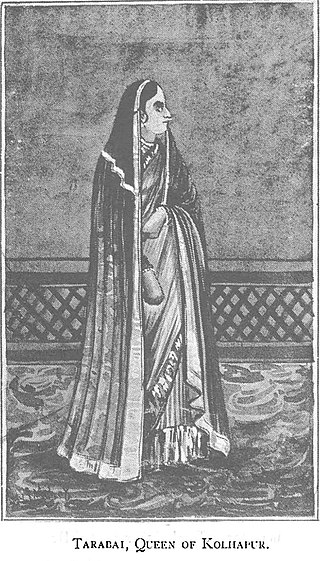
Tarabai Bhosale (née Mohite) was the regent of the Maratha Empire from 1700 until 1708. She was the queen of Rajaram I, and daughter-in-law of the empire's founder Shivaji I. She is acclaimed for her role in keeping alive the resistance against Mughal occupation of Maratha territories after the death of her husband, and acting as the regent during the minority of her son, Shivaji II.
Hambirrao Mohite also known as Hansaji, was a prominent Maratha general who held the esteemed position of the 5th Senapati of the Maratha Army during the reign of Chhatrapati Shivaji. He was recognized for his exceptional military prowess and successfully led various campaigns on behalf of Shivaji, subsequently continuing his service under Chhatrapati Sambhaji.

The Deccan wars were a series of military conflicts between the Mughal Empire and the descendants of the Maratha ruler Shivaji from the time of Shivaji's death in 1680 until the death of Emperor Aurangzeb in 1707. Shivaji was a central figure in what has been called "the Maratha insurgency" against the Mughal state. Both he and his son, Sambhaji, or Shambuji, typically, alternated between rebellion against the Mughal state and service to the Mughal sovereign in an official capacity. It was common practice in late 17th-century India for members of a ruling family of a small principality to both collaborate with the Mughals and rebel.
Ashta Pradhan was a system of ministerial delegation in the Maratha empire. The council is credited with having implemented good governance practices in the Maratha heartland, as well as for the success of the military campaigns against the Mughal Empire.

Saibai Bhosale was the first wife and chief consort of Chattrapati Shivaji, the founder of the Maratha Empire. She was the mother of her husband's successor Chattrapati Sambhaji.

The House of Mohite or Mohite clan is a prominent Maratha clan, that held significant positions as Senapati and Sardar within the Maratha Empire. The House of Mohite was established by Sambhaji Mohite, who served as the Subedar of Saswad and was the brother of Shahaji's wife, Tukabai. He was also the father of Soyarabai, who later became the wife of Chhatrapati Shivaji. His son Hambirrao Mohite became the Senapati of the Maratha Empire. The Mohite clan played significant role during the Mughal-Maratha wars.

Kolhapur State or Kolhapur Kingdom (1710–1949) was a Maratha princely State of India, under the Deccan Division of the Bombay Presidency, and later the Deccan States Agency. It was considered the most important of the Maratha principalities with the others being Baroda State, Gwalior State and Indore State. Its rulers, of the Bhonsle dynasty, were entitled to a 19-gun salute – thus Kolhapur was also known as a 19-gun state. The state flag was a swallow-tailed saffron pennant.
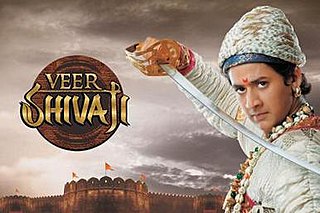
Veer Shivaji is an Indian historical drama series that aired on Colors TV. The show focuses on the life of Shivaji, the 17th century founder of the Maratha Empire. It premiered on 2 September 2011 and was produced by Contiloe Telefilms, who had earlier created the historical drama Jhansi Ki Rani on Zee TV. Due to the instant success and popularity and with TRP of more than 2.60, the show timing were extended to five days a week from 3 October 2011.

Vasudeo Sitaram Bendrey was historian, author, editor, translator and publisher in Marathi language. He is known as Bhishmacharya of Marathi History. He dedicated his work for research in Maharashtra history and wrote, edited and translated over 60 books on different history topics.
Annaji Datto Sachiv was the Sachiv in the Ashta Pradhan mandal of the Maratha Empire during the rule of Shivaji.
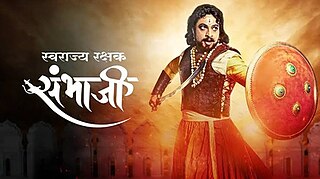
Swarajyarakshak Sambhaji is an Indian historical drama based on the life of warrior king Sambhaji. The series is directed by Vivek Deshpande and Kartik Rajaram Kendhe and is written by Pratap Gangavane. It is produced abd starred by Amol Kolhe in lead role of Sambhaji, Vilas Sawant and Sonali Ghanashyam Rao under the banner of Jagadamb Creations. It premiered from 24 September 2017 by replacing Kahe Diya Pardes and aired on Zee Marathi.

Raja Shivchatrapati is a Marathi historical TV drama based on Chhatrapati Shivaji Maharaj, founder of the Maratha Empire. The serial was re-broadcast in April 2020 during the COVID-19 pandemic.
Sarsenapati Hambirrao is an Indian Marathi-language historical war film written and directed by Pravin Tarde and produced by Sandeep Mohite Patil, Saujanya Nikam and Darmendra Bora under banner of Urvita Productions. The film stars Pravin Tarde, Gashmeer Mahajani, Mohan Joshi in lead roles. The film is based on life of Military Commander of Maratha Empire Hambirrao Mohite. The film released worldwide on 27 May 2022.

Chhatrapati Sambhaji is an Indian Marathi-language historical drama film traces the real life story of Sambhaji, the second chatrapati of the Maratha Empire. The film is directed by Rakesh Subesingh Dulgaj starring Shashank Udapurkar in the title role, and Pramod Pawar, Rajit Kapur, Mrinal Kulkarni in the other principal roles.
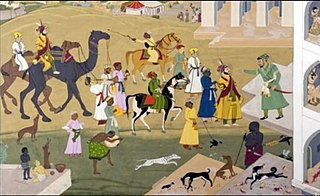
The Execution of Sambhaji was a significant event in 17th-century Deccan India, where the second Maratha King was put to death by order of the Mughal emperor Aurangzeb. The conflicts between the Mughals and the Deccan Sultanates, which resulted in the downfall of the Sultanates, paved the way for tensions between the Marathas and the Mughals. Following the death of Shivaji, his son Sambhaji ascended to the throne and conducted several campaigns against the Mughals. Unlike his father, Sambhaji tolerated instances of rape and murder committed by his army during these conflicts. This led Aurangzeb to launch a campaign against the Marathas, resulting in the capture of the Maratha King by the Mughal general Muqarrab Khan. Sambhaji and his minister Kavi Kalash were then taken to Tulapur, where they were tortured to death.
References
- ↑ Jaswant Lal Mehta (1 January 2005). Advanced Study in the History of Modern India 1707-1813. Sterling Publishers Pvt. Ltd. pp. 48–. ISBN 978-1-932705-54-6.
- ↑ PAWAR, Dr JAYSINGRAO (1 March 2018). SHIVCHATRAPATI: EK MAGOVA (in Marathi). Mehta Publishing House. ISBN 978-93-87789-16-6.
- ↑ N C Kelkar. Shivaji Nibandhavali Vol.i.
- ↑ Sushila Vaidya (1 January 2000). Role of women in Maratha politics, 1620-1752 A.D. Sharada Pub. House. ISBN 978-81-85616-67-4 . Retrieved 6 March 2012.
- ↑ Maharani Tarabai of Kolhapur, C. 1675-1761 A.D.,Śālinī Pāṭīla, pg 22
- ↑ Shivaji Maharaja Maratha Chhatrapati In Bharat-varsha, Anant V. Darwatkar, p.180
- ↑ . Gordon, Stewart (1993). The Marathas 1600–1818 (1st publ. ed.). New York: Cambridge University. p. 91. ISBN 978-0-521-26883-7. Retrieved 5 June 2016
- ↑ Jaswant Lal Mehta (1 January 2005). Advanced study in the history of modern India 1707-1813. Sterling Publishers Pvt. Ltd. p. 48. ISBN 978-1-932705-54-6 . Retrieved 6 March 2012.
- ↑ Sarkar, Jadunath, Sir (1979) [1940]. The house of Shivaji: Studies and documents on Maratha history, Royal period. Orient Longman. pp. 197, 198. ISBN 0-86131-086-1. OCLC 153928919.
{{cite book}}: CS1 maint: multiple names: authors list (link) - ↑ जिंजीचा प्रवास, VS Bendrey, pg. 6
- ↑ ज्वलज्वलनतेजस संभाजीराजा by Dr Sadashiv Shivade